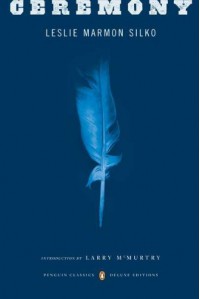Ceremony
 He could see the story taking form in bone and muscle
He could see the story taking form in bone and muscleAfter reading a few Sherman Alexie books a few years ago, Leslie Marmon Silko’s Ceremony started popping up in my suggestions, and for some reason, I thought it was poetry rather than a novel. Once I read the description, I put it on my wishlist, where it languished for several months until I finally bought a copy last summer at The Last Bookstore in downtown Los Angeles on a long lunch break from jury duty. I’ve pulled it off my bookshelf a few times when looking for my next read but never quite pulled the trigger until now.
Half-white Tayo has returned to New Mexico after surviving World War II but without his cousin and best friend, Rocky, whom Tayo carried until he died during the Bataan death march. Haunted by Rocky’s death and the other horrors of war, Tayo suffers from what they then called “shell shock” but what we now call PTSD. His life is kind of a mess, and it’s only getting worse. He can’t sleep, can’t keep anything down, has flashbacks to the war, and like many of his compatriots who went over as heroes and came back as nobodies, he drinks too much and gets himself into trouble, like stabbing another man in the gut with a broken beer bottle during a fight. Tayo’s family tells him he needs help or he’ll have to go back to the army hospital, so he relents and goes to see Old Betonie, who performs a ceremony for him and tells him what he needs to do to get himself well. No small task, since Tayo is burdened not only by his own circumstances and mixed heritage but also the history of his whole people.
Though it is a novel, it does contain a great deal of poetry, both in the form and language of small interludes of Native American legends, and in the prose itself, some of the most beautiful I’ve read, such as:
“. . . he waited to die the way smoke dies, drifting away in currents of air, twisting in thin swirls, fading until it exists no more.”
And:
“It took only one person to tear away the delicate strands of the web, spilling the rays of sun into the sand, and the fragile world would be injured.”
And:
“He wanted to fade until he was as flat as his own hand looked, flat like a drawing in the sand which did not speak or move, waiting for the wind to come swirling along the ground and blow the lines away.”
For a book published in the 1970’s, it’s remarkably (and sadly) relevant today. In a few brilliant paragraphs about three-quarters of the way through, Silko throws down a fireball of a critique of white people and their role in racial injustice that is one of the most insightful and scathing I’ve read. Even beyond that, the whole book just feels very modern. The storyline is non-linear and fluid and dreamlike, reflecting Tayo’s physical and psychological torment. It’s very dense, with thick paragraphs and no defined chapters, only extra line breaks and bits of poetic legend now and then. It’s not the easiest story to follow and took me quite awhile to read, given its relatively short length, but it was very much worth my time.
(This review was originally posted as part of Cannonball Read 10: Sticking It to Cancer, One Book at a Time.)



